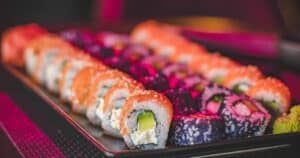Have you ever watched a sushi chef skillfully roll a thick, colorful sushi roll and wondered how they do it? The art of futomaki, a delicious thick sushi roll, is a fascinating blend of technique and creativity. Each roll bursts with vibrant ingredients, creating a feast for both the eyes and the taste buds.
Overview of Futomaki Thick Roll Technique
Futomaki is a special kind of sushi roll that’s big and colorful. Each roll is like a little party of flavors. I’ve found that making these rolls takes skill and creativity.
Characteristics
- Size: Futomaki rolls are usually 2 to 2.5 inches (5-6 cm) wide. They look huge compared to other sushi rolls.
- Ingredients: Lots of ingredients make futomaki tasty. Some common ones are:
- Unagi (eel)
- Anago (saltwater eel)
- Kanpyo (dried gourd strips)
- Spinach
- Sakura denbu (sweet codfish flakes)
- Tamagoyaki (sweet rolled omelet)
- Cucumber
- Kamaboko (imitation crab)
- Pickled ginger
- Carrots
- Sashimi (like tuna or salmon)
- Shiso leaves (a type of herb)
- Koya dofu (freeze-dried tofu)
It’s likely that some rolls may include other ingredients, but these are the most popular.
Preparation
The steps to make futomaki look easy, but I know they require practice.
- Rice: First, sushi rice gets cooked and seasoned. Then, it’s spread on a nori (seaweed) sheet, leaving some space at the top.
- Fillings: Next, the ingredients are laid out in the center. It’s important to keep them in one layer, so they don’t fall out.
- Rolling: Finally, the nori sheet gets rolled up tightly using a bamboo mat. Pressing gently helps form a perfect roll.
History of Futomaki
Futomaki has an interesting story. It comes from Japan, specifically the Kansai region. This area includes cities like Kyoto and Osaka. People often make futomaki during special events, especially during Setsubun. Setsubun is a fun celebration that happens just before spring starts.
Origin and Evolution
Futomaki started as a special festival food in Kansai. Over the years, its ingredients changed. Originally, cooks used simple items. Now, they include tasty things like:
- Unagi (freshwater eel)
- Anago (saltwater eel)
- Kanpyo (gourd strips)
- Spinach
- Mitsuba (Japanese wild parsley)
These ingredients sit on top of sushi rice. Chefs roll everything in nori, a type of dried seaweed. It’s likely that people chose these items to create a balance of flavors and textures.
Cultural Significance
Eating futomaki isn’t just about tasting something good. It’s also about celebrating! People often enjoy futomaki during family gatherings and festivals. The big, colorful rolls symbolize good luck and happiness. Eating them can bring people together. During Setsubun, some believe eating a whole futomaki roll while facing a lucky direction can bring you good fortune.
Key Components of Futomaki
Futomaki is an exciting sushi roll that’s both colorful and tasty. This thick roll has its own unique style, and it’s fun to learn about what makes it special!
Ingredients Used
Futomaki can be filled with all kinds of yummy ingredients. Here are some common ones:
- Vegetables: You might find cucumber, asparagus, avocado, spinach, or pickled burdock root (gobo) in the roll. Each veggie adds a different taste.
- Protein: Common choices include tamago, a sweet Japanese omelette, and sakura denbu, which are seasoned codfish flakes. Sometimes, people even add cooked eel or imitation crab.
- Other Fillings: You can also use seasoned mushrooms, kanpyo (that’s dried calabash gourd), and inari sushi, which is seasoned fried tofu.
Who knows what new mix of ingredients you could come up with? People love to get creative.
Equipment Needed
To make futomaki, you’ll need a few special tools. Here’s a list of what you might want:
- Bamboo Sushi Mat (Makisu): This tool helps shape the sushi roll into its thick form. Rolling with it takes practice!
- Nori: You’ll need full sheets of dried seaweed. Nori holds everything together, so it’s super important.
It’s likely you’ll have a fun time experimenting with these tools. Making futomaki is about trying new things and finding what you like best.
The Futomaki Rolling Process
Making futomaki can be exciting! This thick sushi roll is fun to create, and it involves a specific process that transforms simple ingredients into a delicious dish. Attention to detail is important for making these rolls just right.
Step-by-Step Guide
- Prepare Ingredients:
- Use short-grain Japanese rice, like Koshihikari. This rice is sticky and moist, perfect for rolling.
- Gather fillings like kampyo, inari, spinach, shitake mushrooms, and tamago. These ingredients add great flavor.
- Measure and Prepare Rice:
- Measure 1 and 1/2 cups of rice. Moisten the inside of your measuring cup with vinegared water. This helps the rice not stick.
- Spread the rice evenly over a nori sheet. Leave a 1-inch strip at the farthest edge. This area helps seal the roll later.
- Add Fillings:
- Place fillings like kampyo and mushrooms in the center of the rice. You can be creative! Try different combinations to make your roll special.
Common Mistakes to Avoid
Crafting futomaki is fun, but there are a few mistakes I noticed that can happen:
- Not wetting the measuring cup first. This makes rice clump together and can be messy.
- Using too much filling. Too many ingredients can make it hard to roll up the sushi tightly.
- Forgetting to leave space at the edge of the nori. If not done, it can lead to a messy roll that falls apart.
Popular Variations of Futomaki
Futomaki comes in many tasty versions that make each bite exciting. Different ingredients can change the flavors and textures. Here are some popular types:
Traditional Futomaki
Traditional futomaki includes a mix of ingredients to create rich flavors. You might find combinations like:
- Unagi or Anago: Tasty eel adds a unique, sweet flavor.
- Kanpyo: These gourd strips add a sweet, chewy texture.
- Spinach: Fresh spinach gives a nice color and health benefits.
- Sakura Denbu: Pink codfish flakes make it pretty and tasty.
- Tamagoyaki: This sweet omelette adds softness and flavor.
- Cucumber: Crunchy cucumber brings freshness to every bite.
- Kamaboko: Imitation crab adds a delicate seafood taste.
- Pickled Ginger: It provides a zesty kick that balances flavors.
- Carrots: Shredded carrots add sweetness and crunch.
- Sashimi: Tuna or salmon gives a luxurious seafood flavor.
- Shiso Leaves: These leaves add a unique, herby taste.
- Koya Dofu: Freeze-dried tofu adds protein and texture.
These ingredients all work together and create a delightful combination.
Vegetarian Futomaki
Vegetarian futomaki skips the seafood and focuses on plants. It often includes:
- Tamago: A sweet Japanese omelette for flavor and protein.
- Seasoned Shiitake Mushrooms: These mushrooms bring an earthy taste that’s hard to resist.
- Spinach: Like in traditional rolls, it adds color and health.
- Seasoned Kampyo: This gourd adds a touch of sweetness to the mix.
Vegetarian futomaki is likely to be fun for those who prefer plant-based meals. Many people enjoy the challenge of creating new flavors with different ingredients.
Regional Differences
Futomaki can vary by region. Each area might choose ingredients based on what’s local or popular. Some regions might add different kinds of fish or vegetables. Others might have special sauces or spices. It’s fun to think about how different areas make their rolls unique.
| Region | Common Ingredients |
|---|---|
| Kansai | Eel, gourd strips, pickled ginger |
| Kanto | Raw fish like tuna or salmon, cucumber |
| Hokkaido | Crab, seaweed salad, avocado |
Creative Twists
Many sushi lovers like to experiment. Adding ingredients can give futomaki a fun twist. Some ideas include:
- Fruits: Fresh mango or strawberry can make a sweet roll.
- Spices: Adding spicy mayo could surprise your taste buds.
- Crunchy Toppings: Sprinkling sesame seeds on top gives extra texture.
People might also play with shapes. Instead of the classic roll, some make futomaki that looks like a flower. Others create mini rolls for a fun snack.
Conclusion
Mastering the futomaki thick roll technique opens up a world of culinary creativity. Whether you’re sticking to traditional ingredients or experimenting with new flavors and shapes, each roll tells a story. I’ve found that the joy of making futomaki lies not just in the taste but in the entire process.
Sharing these rolls with family and friends brings a sense of connection and celebration. So grab your mat and start rolling. You’ll soon discover that futomaki isn’t just a dish; it’s an experience that enriches any gathering. Enjoy the journey and let your creativity shine through each unique roll you create.




